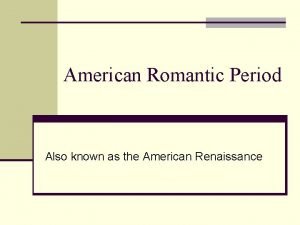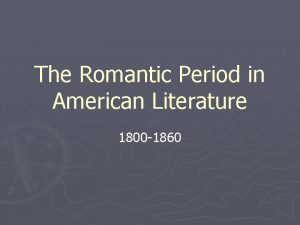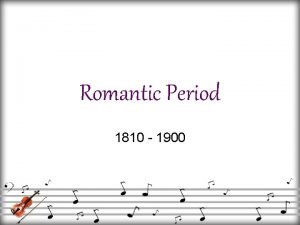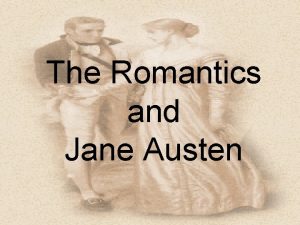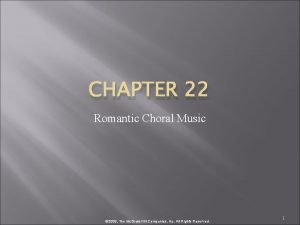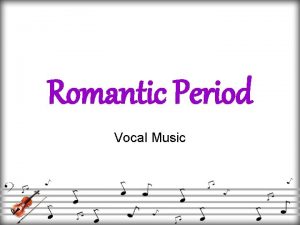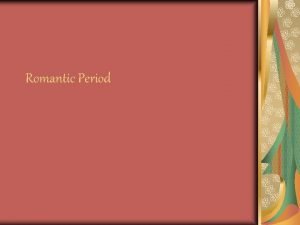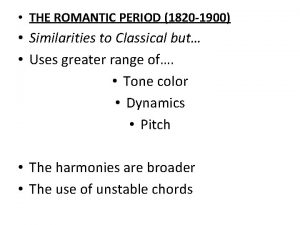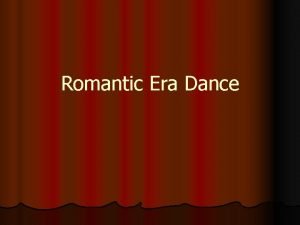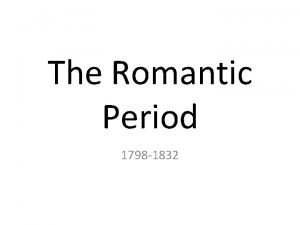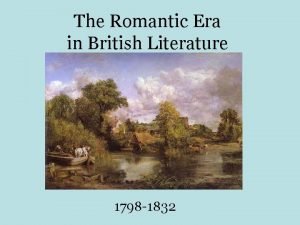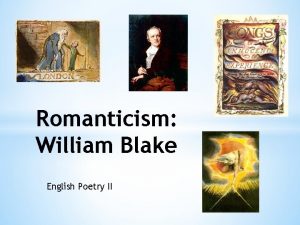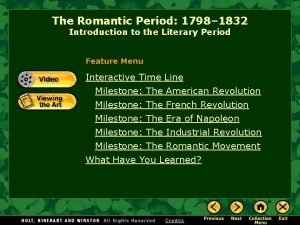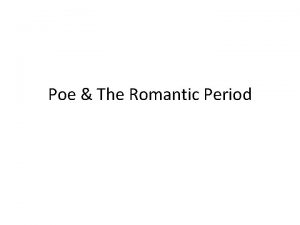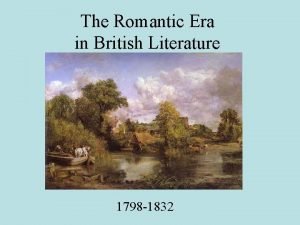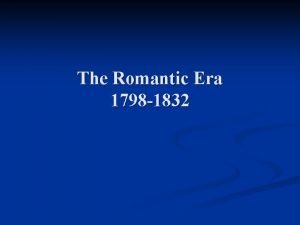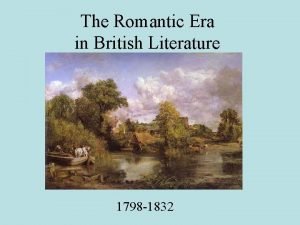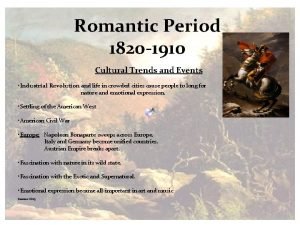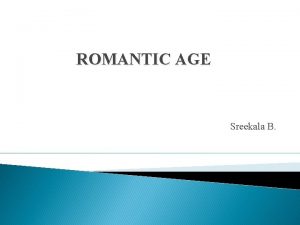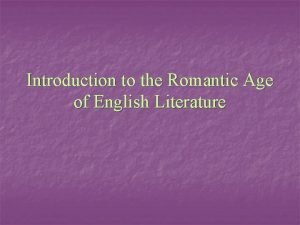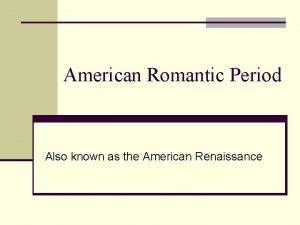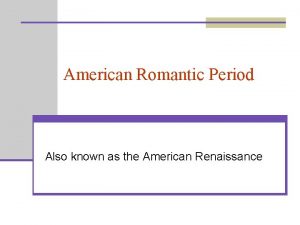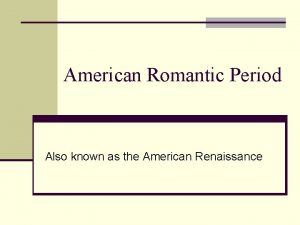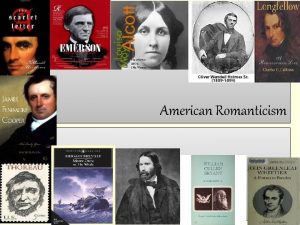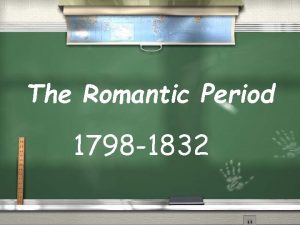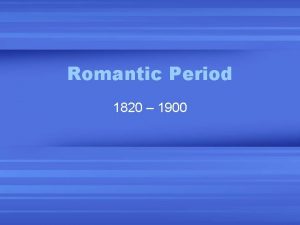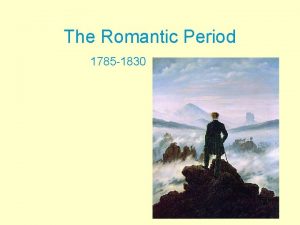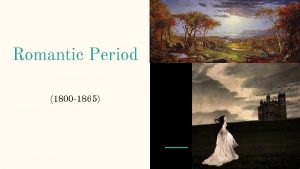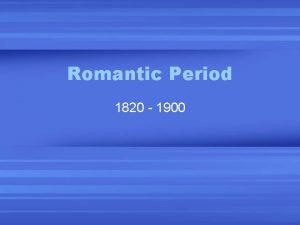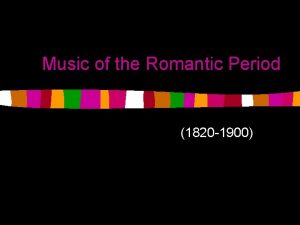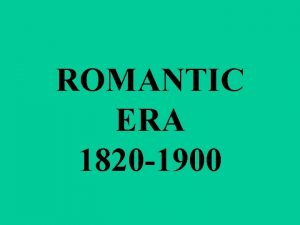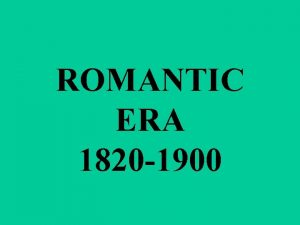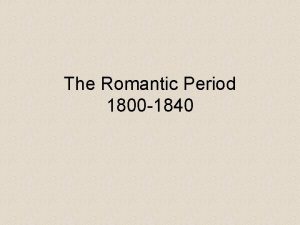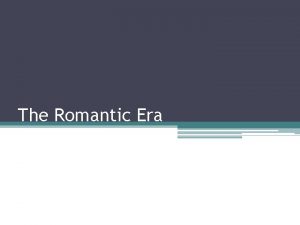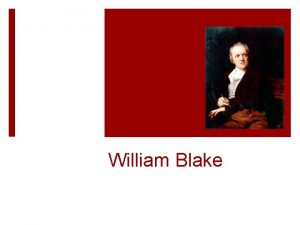American Romantic Period Also known as the American

































- Slides: 33

American Romantic Period Also known as the American Renaissance

The Romantic Period n The "Romantic Period" refers to literary and cultural movements in England, Europe, and America roughly from 1770 to 1860. Romantic writers (and artists) saw themselves as revolting against the "Age of Reason" (1700 -1770) and its values. They celebrated imagination/intuition versus reason/calculation, spontaneity versus control, subjectivity and metaphysical musing versus objective fact, revolutionary energy versus tradition, individualism versus social conformity, democracy versus monarchy, and

Romantic vs. Non-Romantic n ROMANTIC NON-ROMANTIC/Reason/Classic n Emotional Individualistic Revolutionary Loves Solitude & Nature Fantasy/Introspection The Particular Subjective Perception Satisfaction of Desire Organic Creative Energy/Power Exotic "Noble Savage"/Outcasts Idealist Philosophy Reasonable and Practical Public Responsibility Conservative Loves Public, Urban Life External Reality The Universal Objective Science Desire Repressed Mechanical Form Mundane Bourgeois Family Materialist/Empirical Philosophy n n n

Romanticism: • Reaction against rationalism • Value feeling and intuition over reason • “A journey away from the corruption of civilization and the limits of rational thought and toward the integrity of nature and the freedom of the imagination” • Art = intuitive, “felt” experience • Poetry = highest and most sublime embodiment of the imagination • Attacked science

Classical (eighteenth century; “Enlightenment, ” scientific revolution, “Age of Reason”) stylistic tendencies: hard edges, clear colors, focused light subject tendencies: historical figures, social and historical settings, human figures in foreground Audubon, Gyrfalcon Romantic painting stylistic tendencies: softer edges and colors, diffuse light subject tendencies: nature, human figures in background, human figures diminished, human figures not historical but fictional or “types” Heade, Hummingbirds & Orchids

Indian Pass by Thomas Cole

Kindred Spirits by Asher Brown Durand

Landscape scene from the Last of the Mohicans by Thomas Cole

Characteristics of American Romanticism 1. Values feeling & intuition over reason 2. Places faith in inner experiences & the power of the imagination 3. Prefers youthful innocence to educated sophistication 4. Individual freedom & the worth of the individual 5. Contemplates nature’s beauty as a path to spiritual and moral development

1800 - 1860 What’s going on in the world: n 1803 – Louisiana Purchase n 1810 – Mexico begins it’s war of independence from Spain n 1812 – British attempt to take back America in the War of 1812 n 1815 – Napoleon defeated at Waterloo n 1820 -1821 – Missouri Compromise (free state/ slave state) n 1830 – Underground railroad begins n 1837 – Queen Victoria rules England n 1845 – United States annexes Texas (leads to war with Mexico in 1846) n 1849 – California gold rush n 1854 – Republican party formed (opposed extension of slavery) n 1858 – England takes over rule of India

Louisiana Purchase n From France n 4 cents an acre (15 million dollars total) n Doubled US Territory

The Gold Rush 1848 - 1855 n Helped to develop the West n Led to the building of railroads n California and Alaska were major rushes

Romanticism n NOT about love n Values feeling and intuition over reason n Romantics believed that imagination could discover truths that the rational mind could not n Nature is very important Those who dream by day are cognizant of many things which escape those who dream only by night. -Edgar Allan Poe

Characteristics of the American Romantic period n n n n n Values feeling and intuition over reason Values the imagination over reality Civilization is bad Nature is good Educated sophistication is bad Youthful innocence is good Individual freedom is important Nature is the way to find God Progress is bad Most settings are in exotic locales or the supernatural Poetry is the highest expression of the imagination Lots of inspiration from myths and legends

The American Hero n Young (or at least acts n n n young) Innocent and pure Sense of honor higher than society’s honor Has knowledge of people and life based on a deep understanding, not based on education Loves nature Quests for a higher truth

The Hero n First American Hero – created by James Fennimore Cooper: Natty Bumppo (went by other names – Hawkeye, Deerslayer, and Leatherstocking)

The Fireside Poets n Henry Wadsworth Longfellow n John Greenleaf Whittier n Oliver Wendell Holmes n James Russell Lowell

Fireside Poets n American poets who first rivaled British poets in popularity were fireside poets. These romantic poets were sentimental in their writing. In schoolrooms, children memorized and recited the poems. The rhyming meters made the poems easy to learn. n In the evening, around the hearth, parents read the poems to their children. These were the poets that captured the romantic spirit of America. The fireside poets were family entertainment to a young nation. Children and adults had no television or radio to entertain them. n n

Fireside Poets: Longfellow n The fireside poets used the fire in the fireplace as a metaphor. Listening to the words of the poet lit the imagination of the listener. One fireside poet, Henry Wadsworth Longfellow, wrote, “Poetry should soothe our worldly passions and inspire us with a love of Heaven and virtue. ” n The Midnight Ride of Paul Revere by Longfellow is an example of the fireside poet. Although ostensibly written about the Revolutionary War, it was written about the upcoming Civil War. Longfellow used history as a legend to warn New Englanders to take action against slavery. It was written in 1860, the eve of the Civil War when South Carolina seceded from the union. n In 1967, Martin Luther King recognized the parable of the Midnight Ride in his speech, “Paul Revere of conscience to alert every hamlet and every village of America that revolution is at hand. ”

Whittier n John Greenleaf Whittier brings the idea of a snowstorm as frightening to a small child, but the warmth radiating from the fireplace makes the child realize the security of the family gathered around the hearth. This is the poem that made Whittier famous, Snow-Bound: A Winter Idyl (1866). Think of the security the imagery of this poem would instill in a family. n The oaken log, green, huge, and thick, n And on its top the stout back-stick; n The knotty forestick laid apart,

Whittier, like Longfellow, was ardent against slavery. In 1835, Whittier was mobbed and stoned in Concord, New Hampshire for his antislavery views. The poem was written at the end of the Civil War. He writes, The darkness and the ignorance, The pride, the lust, the squalid other Which nurtured Treason’s monstrous growth, For Slavery’s lash the freeman’s will, For blind routine, wise-handed skill;

Holmes Oliver Wendell Holmes’ poem, The Chambered Nautilus (1858), is reminiscent of metaphysical poets. He compares the shellfish to humans. Holmes’s premise is that it is difficult to separate humans from the shellfish. Like the shellfish, humans become aware of, and outgrow their old prejudices. The speaker in the poem stares in fascination at the shellfish. Holmes writes, n Build thee more stately mansions, O my soul, As the swift seasons roll! Leave thy low-vaulted past! Let each new temple, nobler than the last, Shut thee from heaven with a dome more vast, Till thou at length art free, Leaving thine outgrown shell by life’s unresting sea!”

Transcendentalism § The idea that in determining the ultimate reality of God, the universe, the self, and other important matters, one must transcend, or go beyond, everyday human experience in the physical world. § Ralph Waldo Emerson influenced by ancient Greek - Plato § Also based on Puritan belief and Romantics § Based on intuition; optimistic § Henry David Thoreau Emerson’s close friend

Transcendentalism (time overlap): 1840 -1860 n Weird n Believed in human perfectibility n Ralph Waldo Emerson’s poem “Nature. ”

Whitman and Dickinson 19 th century’s greatest poets § Spoke to the masses § Obscure homebody § Universal brotherhood, § In nature, found democracy metaphors for the spirit § Aimed for overall impression, free verse § Meticulous word based on cadence choice, precise language, evoking feelings

Dickinson § The main characteristic of Romanticism that Emily Dickinson portrays in her writing is the emphases of the importance of Nature to the Romantics. § In most of her poems there is some mention or comparison to something found in Nature. In Poem 449, she refers to the moss that covers the names on the graves of the tombstones of “Beauty” and “Truth. ” § The Puritans believed Nature to be the realm of the devil. By including references to Nature in many of her poems, she was rebelling against the ideals of the Puritan upbringing she had hated so much.

The Dark Romantics n Nathaniel Hawthorne, Edgar Allan Poe, Herman Melville n Believed what the Romantics did, but felt that at the core of everyone was a dark, sinister being n Have a lot of crazy or guiltracked people in their stories

American Gothic The Dark Side of Individualism

The Beginnings… Gothic Literature Gothic Literary tradition came to be in part from the Gothic architecture of the Middle Ages. Gothic cathedrals with irregularly placed towers, and high stained-glass windows were intended to inspire awe and fear in religious worshipers.

small deformed creatures squatting at the corners and crevices of Gothic cathedrals—were supposed to ward off evil spirits, but they often look more like demonic spirits themselves. • Think of the gargoyle as a mascot of Gothic, and you will get an idea of the kind of imaginative distortion of reality that Gothic represents.

Gothic vs. Romanticism � Romanticism developed as a reaction against the rationalism of the Age of Reason. � The romantics freed the imagination from the hold of reason, so they could follow their imagination wherever it might lead. � For some Romantics, when they looked at the individual, they saw hope (think “A Psalm of Life”). Romantic writers celebrated the beauties of nature. For some Romantic writers, the imagination led to the threshold of the unknown— the shadowy region where the fantastic, the demonic and the insane reside. When the Gothics saw the individual, they saw the potential of evil. Gothic writers were peering into the darkness at the supernatural.

Edgar Allan Poe � His stories have: �Settings that featuring ○ Dark, medieval castles ○ Decaying ancient estates �Characters that are ○ Male—insane ○ Female—beautiful and dead (or dying) �Plots that include ○ Murder ○ Live burials ○ Physical and mental torture ○ Retribution from beyond the grave For Poe, it was only in these extreme situations that people revealed their true nature.

Gothic Movement in America The Gothic Tradition was firmly established in Europe before American writers had made names for themselves. By the 19 th century, Edgar Allan Poe, Nathanial Hawthorne, and to a lesser extent Washington Irving and Herman Melville were using the Gothic elements in their writing. Edgar Allan Poe was the master of the Gothic form in the United States.
 Classical period started from 1750 to 1872
Classical period started from 1750 to 1872 American romantic period
American romantic period The romantic period in american literature
The romantic period in american literature Romantic period american literature
Romantic period american literature Romantic period characteristics
Romantic period characteristics Cavalier and metaphysical poetry
Cavalier and metaphysical poetry Jane austen romanticism
Jane austen romanticism The romantic period 1798 to 1832
The romantic period 1798 to 1832 Romantic period 1798 to 1832
Romantic period 1798 to 1832 Romantic period choral music
Romantic period choral music Vocal music of the romantic period
Vocal music of the romantic period Characteristic of romantic period
Characteristic of romantic period Characteristic of romantic period
Characteristic of romantic period Enumerate the vocal music of the romantic period
Enumerate the vocal music of the romantic period Romantic era ballet
Romantic era ballet The romantic age (1798 to 1824)
The romantic age (1798 to 1824) Romantic period elements
Romantic period elements British literature romantic period
British literature romantic period Characteristics of romanticism
Characteristics of romanticism Romantic period in british literature
Romantic period in british literature Romantic period poetry characteristics
Romantic period poetry characteristics Romantic period
Romantic period Romantic theater
Romantic theater The romantic period 1798 to 1832 summary
The romantic period 1798 to 1832 summary Romantic period dates
Romantic period dates Period of activism 1970 1972
Period of activism 1970 1972 1798 in english literature
1798 in english literature The romantic period 1798 to 1832 summary
The romantic period 1798 to 1832 summary Explain romanticism
Explain romanticism British literature romantic period
British literature romantic period Wagner romantic era
Wagner romantic era Music of the romantic period
Music of the romantic period Characteristics of romantic period
Characteristics of romantic period What is romantic age in literature
What is romantic age in literature

